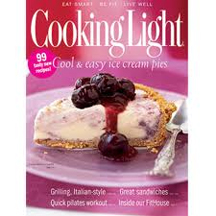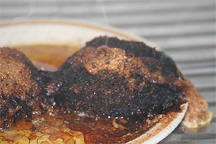Cooking Boo Boos
We've All Made
By Alice Osborne
 My aunt Annie loved to cook and bake, and subscribed to all sorts of cooking magazines. One of her favorite magazines (I'm guessing this because she had several year's worth of them) was Cooking Light. Just for drill I went flipping through them and found some really interesting information on cooking faux pas that are pretty universal. The article listed 31, but rather than throw them all at you all at once, I'm going to share them over a period of three newsletters - so stick with me!
My aunt Annie loved to cook and bake, and subscribed to all sorts of cooking magazines. One of her favorite magazines (I'm guessing this because she had several year's worth of them) was Cooking Light. Just for drill I went flipping through them and found some really interesting information on cooking faux pas that are pretty universal. The article listed 31, but rather than throw them all at you all at once, I'm going to share them over a period of three newsletters - so stick with me!
 1. We don't taste as we go. Result: The flavors or textures of an otherwise excellent dish are out of balance or unappealing.
1. We don't taste as we go. Result: The flavors or textures of an otherwise excellent dish are out of balance or unappealing.
For most cooks, tasting is automatic, but when it's not, the price can be high. Recipes don't always call for the "right" amount of seasoning, cooking times are estimates, and results vary depending on your ingredients, your stove, altitude... and a million other factors. Your palate is the control factor.
Think that experienced cooks don't forget this most basic rule? Cooking Light Associate Food Editor Tim Cebula was sous chef in a notable restaurant when he served up "caramelized" pineapple that somehow refused to brown. Turns out Tim had coated the fruit in salt, not sugar. "That's why it wouldn't caramelize."
 2. We don't read the entire recipe before we start cooking. Result: Flavors are dull, entire steps or ingredients get left out.
2. We don't read the entire recipe before we start cooking. Result: Flavors are dull, entire steps or ingredients get left out.
Even the best-written recipes may not include all the headline information at the top. A wise cook approaches each recipe with a critical eye and reads the recipe well before it's time to cook. Follow the pros' habit of gathering your mise en place - that is, having all the ingredients gathered, prepped, and ready to go before you turn on the heat.
"Trust me," says former Cooking Light Test Kitchen tester Mary Drennen Ankar, "you don't want to be an hour away from dinner guests arriving when you get to the part of the recipe that says to marinate the brisket overnight or simmer for two hours."
 3. We make unwise substitutions in baking. Result: You wreck the underlying chemistry of the dish.
3. We make unwise substitutions in baking. Result: You wreck the underlying chemistry of the dish.
Substitutions are a particular temptation, and challenge, with healthy cooking. At Cooking Light it's our job to substitute lower-fat ingredients?to change the cooking chemistry a bit while capturing the soul of a dish. When it comes to baking, this is as much science as art.
"I'll get calls from readers about cakes turning out too dense or too gummy," says Test Kitchen Director Vanessa Pruett. "After a little interrogation, I'll get to the truth?that the reader used ALL applesauce instead of a mix of applesauce and oil or butter or went with sugar substitute in place of sugar." Best practice: Follow the recipe, period.
 4. We boil when we should simmer. Result: A hurried-up dish that's cloudy, tough, or dry.
4. We boil when we should simmer. Result: A hurried-up dish that's cloudy, tough, or dry.
This is one of the most common kitchen errors. First, let's clarify what we mean by simmering: A bubble breaks the surface of the liquid every second or two. More vigorous bubbling than that means you've got a boil going. And the difference between the two can ruin a dish.
"I had a friend serve me a beef stew once that gave me a real jaw workout," says Nutrition Editor Kathy Kitchens Downie. "She boiled the meat for 45 minutes instead of simmering it for a couple of hours. She says she just wanted it to get done more quickly. Well, it was 'done,' but meat cooked too quickly in liquid ironically turns out very dry. And tough, really tough."
 5. We overheat the chocolate. Result: Instead of having a smooth, creamy, luxurious consistency, your chocolate is grainy, separated, or scorched.
5. We overheat the chocolate. Result: Instead of having a smooth, creamy, luxurious consistency, your chocolate is grainy, separated, or scorched.
The best way to melt chocolate is to go slowly, heat gently, remove from the heat before it's fully melted, and stir until smooth. If using the microwave, proceed cautiously, stopping every 20 to 30 seconds to stir. If using a double boiler, make sure the water is simmering, not boiling. It's very easy to ruin chocolate, and there is no road back.
Associate Food Editor Julianna Grimes recently made a cake but didn't pay close enough attention while microwaving the chocolate. It curdled. "It was all the chocolate I had on hand, so I had to dump it and change my plans."
 6. We over-soften butter. Result: Cookies spread too much or cakes are too dense.
6. We over-soften butter. Result: Cookies spread too much or cakes are too dense.
We've done it: forgotten to soften the butter and zapped it in the microwave to do the job quickly. Better to let it stand at room temperature for 30 to 45 minutes to get the right consistency. You can speed the process significantly by cutting butter into tablespoon-sized portions and letting it stand at room temperature.
Properly softened butter should yield slightly to gentle pressure. Too-soft butter means your cookie dough will be more like batter, and it will spread too much as it bakes and lose shape. Butter that's too soft also won't cream properly with sugar, and creaming is essential to creating fluffy, tender cakes with a delicate crumb.
 7. We overheat low-fat milk products. Result: The milk curdles or "breaks," yielding grainy macaroni and cheese, ice cream, or pudding. [I had NO idea this was the cause of my less-than-yummy from-scratch puddings and macaroni and cheese!]
7. We overheat low-fat milk products. Result: The milk curdles or "breaks," yielding grainy macaroni and cheese, ice cream, or pudding. [I had NO idea this was the cause of my less-than-yummy from-scratch puddings and macaroni and cheese!]
If you're new to lighter cooking, you may not know that even though you can boil cream just fine, the same is not true for other milk products, which will curdle. The solution is to cook lower-fat dairy products to a temperature of only 180 degrees or less.
Use a clip-on thermometer, hover over the pan, and heat over medium-low or low heat to prevent curdling. And if it curdles, toss and start again. One alternative: Stabilize milk with starch, like cornstarch or flour, if you want to bring it to a boil; the starch will prevent curdling (and it'll thicken the milk, too).
 8. We don't know our oven's quirks and idiosyncrasies. Result: Food cooks too fast, too slow, or unevenly.
8. We don't know our oven's quirks and idiosyncrasies. Result: Food cooks too fast, too slow, or unevenly.
Ideally, every oven set to 350 degrees would heat to 350 degrees. But many ovens don't, including expensive ones, and some change their behavior as they age. Always use an oven thermometer. Next, be aware of hot spots. If you've produced cake layers with wavy rather than flat tops, hot spots are the problem.
SaBrina Bone, who tests in our kitchen, advises the "bread test:" Arrange bread slices to cover the middle oven rack. Bake at 350 degrees for a few minutes, and see which slices get singed?their location marks your oven's hot spot(s). If you know you have a hot spot in, say, the back left corner, avoid putting pans in that location, or rotate accordingly.
 9. We're not careful enough about measuring recipe ingredients. Result: Dry, tough cakes, rubbery brownies, and a host of other textural mishaps.
9. We're not careful enough about measuring recipe ingredients. Result: Dry, tough cakes, rubbery brownies, and a host of other textural mishaps.
In lighter baking, you're using less of the butter and oil that can hide a host of measurement sins. One cook's "cup of flour" may be another cook's 1 1/4 cups. Why the discrepancy? Some people scoop their flour out of the canister, essentially packing it down into the measuring cup, or tap the cup on the counter and then top off with more flour. Both practices yield too much flour.
"Lightly spoon flour into dry measuring cups, then level with a knife," advises Test Kitchen Director Vanessa Pruett. A dry measuring cup is one without a spout. A spout makes it difficult to level off the excess flour with the flat side of a knife. "Lightly spoon" means don't pack it in.
 10. We overcrowd the pan. Result: Soggy food that doesn't brown.
10. We overcrowd the pan. Result: Soggy food that doesn't brown.
Food releases moisture as it's cooked, so leave room for the steam to escape. It's easy to overcrowd a pan when you're in a hurry, particularly if you have to brown a large amount of meat for a beef stew or a lot of potato shreds for the family's hashbrowns. But the brown, crusty bits are critical for flavor, particularly with lower-fat cooking.
A soggy batch of beef going into a Dutch oven will not be a beautiful, rich, deeply flavored stew when it comes out, even if it does get properly tender. This browning principle applies equally to quick-cook foods like crab cakes and chicken breasts. Leave breathing room in the pan, and you'll get much better results. If you need to speed things up, use two pans at once.

Contribute to the Cook'n Club!
DVO would love to publish your article, prose, photography and art as well as your cooking, kitchen and nutrition tips, tricks and secrets. Visit the Newsletter Submission / Win Win for All section in our Forum for more information and details.
